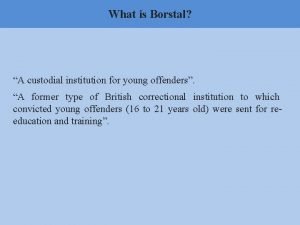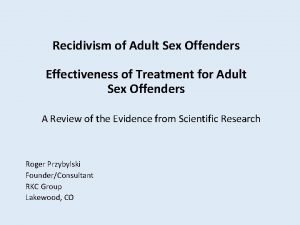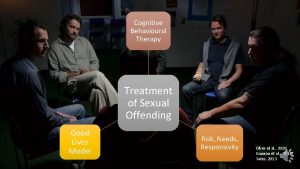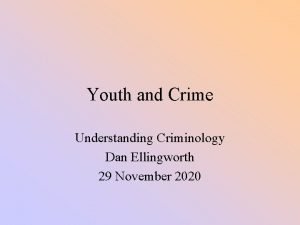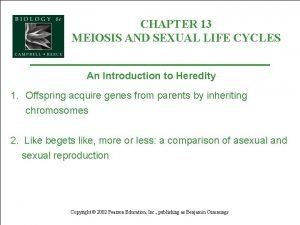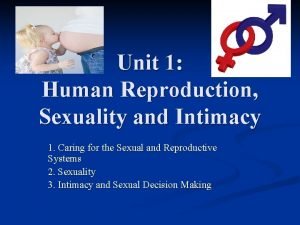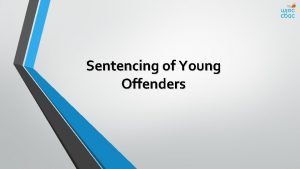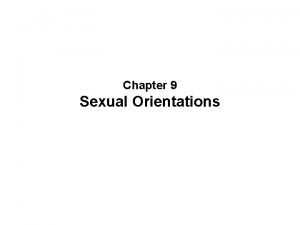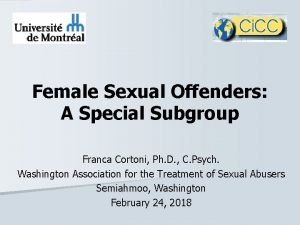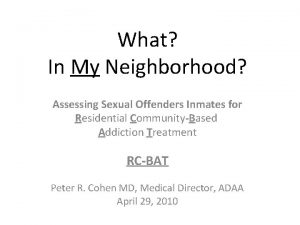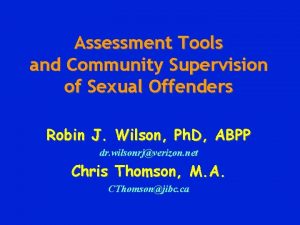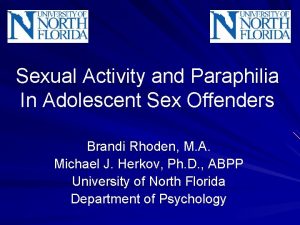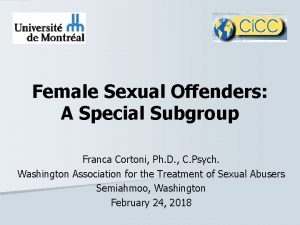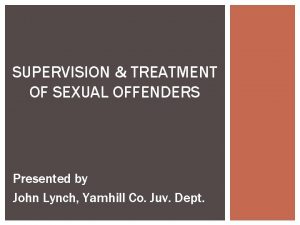Sexual Offenders Chapter 6 What is a sexual














- Slides: 14

Sexual Offenders Chapter 6

What is a sexual offender? n n Sexual assault is usually defined as the “use of force or threat to compel sexual acts” sexual offenders are a highly heterogeneous group n n n Rapists Child molesters Exhibitionist Frotteurist Voyeur

Paraphilia n Recurrent, intense sexual arousing fantasies, sexual urges, or behaviors generally involving non human objects n suffering or humiliation of oneself or partner n children or other non-consenting persons n n n Occurs over a period of 6 months Focus of sexual arousal

Terminology n Child molester n n any adult who has perpetrated a sexual crime against someone under the age of consent (generally around 16 -18 years of age) Pedophile n someone involved in sexual activity or experiencing significant stress over sexual urges or fantasies involving a prepubescent child (usually under 13)

Assessment of Sexual Offenders n Phallometric Measures Physiological device that records deviant response patterns and usually consists of n stimuli, monitoring equipment, and recording instruments n Underlying notion was that sex offenders are motivated to engage in their antisocial behavior by their deviant preferences n Accuracy of measures has been challenged n

Psychological Assessment n Cognitive distortions n Self-serving thoughts patterns that reduce normal barriers to committing acts Victim Empathy n Sexual Fantasies n

Identification of Risk Factors n Meta-analyses on sexual offending have identified several interesting findings n n Strongest predictor of sexual recidivism is phallometric responses toward children and deviant preferences Empathy for victims, denial of sexual offense, low motivation for treatment, and sexual abuse as a child were unrelated to sexual recidivism Sexual offenders are less likely to recidivate for sexual offenses than non sexual offenses Sexual recidivism rates vary with time: 10 -15% after 5 years, 20% after 10 years, and 30 -40% after 20 years n these are likely underestimates

Risk Assessment Instruments for Sex Offenders n SVR-20 n SORAG n Static-99 n Made up of parts of the RRASOR and Structured Actuarial Clinical Judgment

Treatment and Management of Sexual Offenders n Are Sexual Offender Treatment Programs Successful? Hanson et al. (2002) found 12. 3% sexual recidivism rates for treated sex offenders and 16. 8% for untreated sex offenders n Many problems with sex offender treatment literature n Poor comparison groups n Small number of studies n Poor research designs n

Components of Potentially Successful Programs n Cognitive-behavioral n n Target underlying deficits n n n denial and minimization, crime specific distortions, victim empathy self-esteem, social skills, anger, drinking, assertiveness, social perception, performance evaluation, and intimacy deficits Relapse prevention Pharmacological

Special Groups of Sexual Offenders n Juvenile Sex Offenders n n n almost 20% of those arrested for sexual assault are below 18 general recidivism is much higher tend to engage in a variety of nonsexual antisocial behavior commit a wide range of sex offenses many adult sex offenders start in adolescence little is known about female juvenile sex offenders

Female Sex Offenders n n n Compose less than 2% of all sex offenders and less than 2% of all female offenders Between 6 -60% of female victims and 14 -27% of male victims report a female perpetrator Underreporting makes study difficult and most studies have small sample sizes Higher rates of sexual abuse, trauma, psychopathology Little research on exclusive treatment of female sex offenders

Clergy as Sexual Offenders n n John Jay Report: confidential, population-based survey of diocese, clergy, and victims 1950 -2002 3 -6% perpetration rates among Catholic clergy across diocese, 4% overall n n n n most allegations were against parish priests most are 25 -39 at the time of the first allegation 1/3 had substance abuse problems 6. 8% reported they had been abused About 3% had 10+ allegations Police investigated 15%, 5% were criminally charged, and 2 % convicted 40% of incidents occurred in home or parish residence

Sexual Offender Legislation § Registration & Notification Laws § Check-in with local law enforcement § Residency Laws § Prohibit offenders from living with certain distances of areas deemed high risk § Sexually Violent Predator (SVP) Laws § intended to continue a sex offender’s confinement if mentally ill and dangerous § usually aimed at the most dangerous
 Borstal institution meaning
Borstal institution meaning Cognitive behavioral therapy for sex offenders
Cognitive behavioral therapy for sex offenders Juvenile delinquents act canada
Juvenile delinquents act canada Cognitive behavioral therapy for sex offenders
Cognitive behavioral therapy for sex offenders Trait theory juvenile delinquency
Trait theory juvenile delinquency Juvenile delinquency graphic organizer
Juvenile delinquency graphic organizer Youthful offenders act 1854
Youthful offenders act 1854 Sexual reproduction
Sexual reproduction Pedigree miscarriage symbol
Pedigree miscarriage symbol Chapter 10 sexual reproduction and genetics
Chapter 10 sexual reproduction and genetics Metaphase ii
Metaphase ii Chapter 13 meiosis and sexual life cycles
Chapter 13 meiosis and sexual life cycles Wasac
Wasac Reproduction in humans
Reproduction in humans Sexual abuse signs and symptoms
Sexual abuse signs and symptoms
